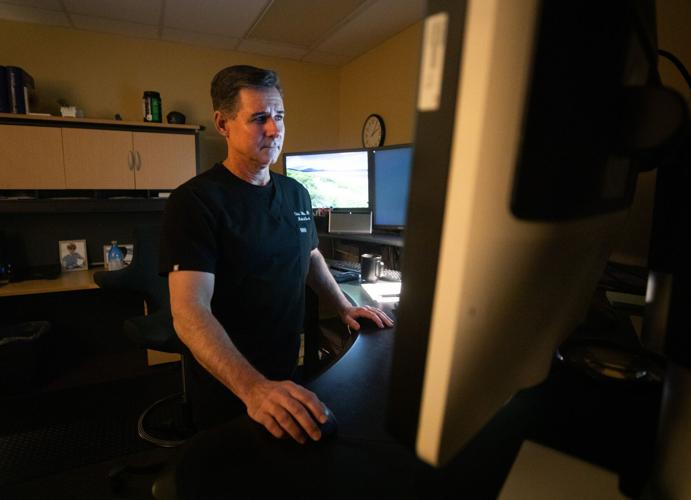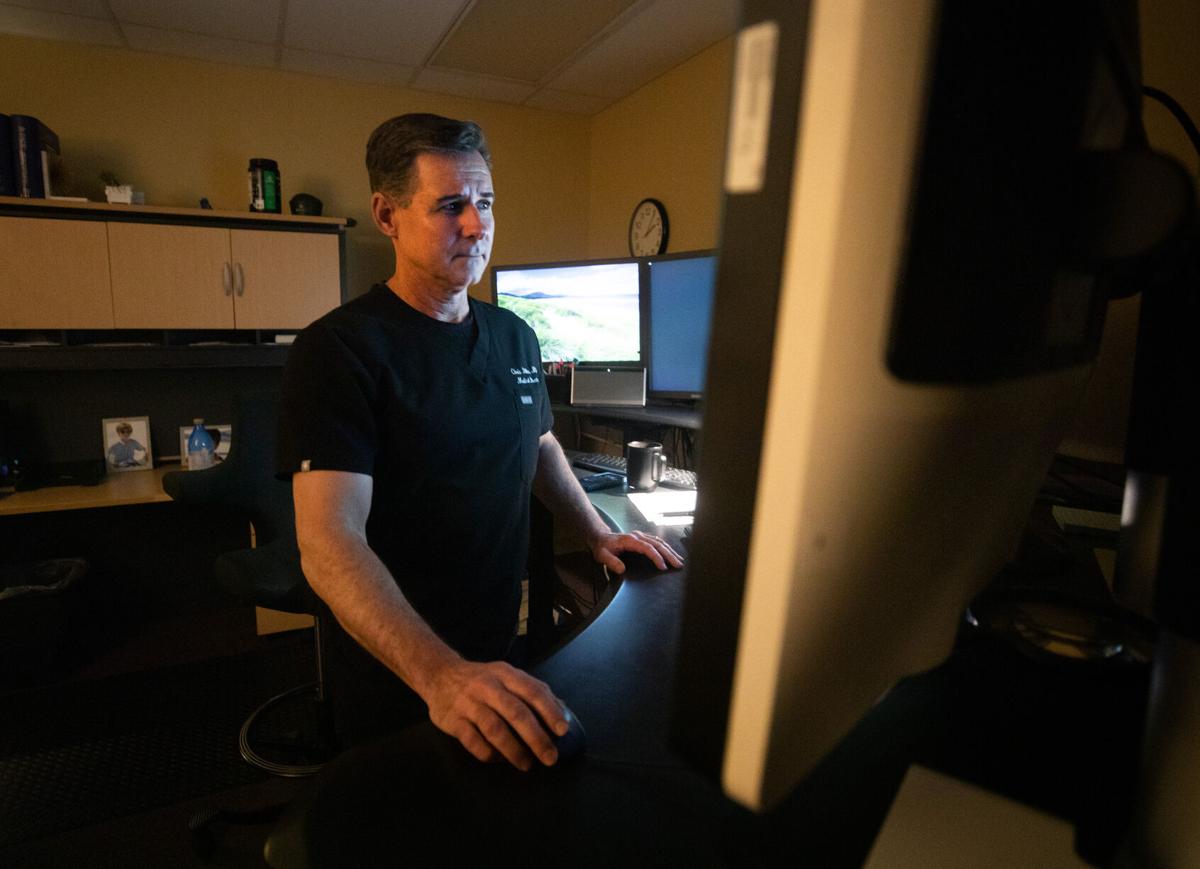New federal guidelines rolling back the starting age for mammogram screening and requiring providers to notify patients with dense breast tissue could help more women detect breast cancer earlier, but local experts say there’s still work to be done.
In 2023, more than 6,240 people will be diagnosed with breast cancer in Arizona and more than 920 will die of the disease, the Susan G. Komen Foundation estimates.
Breast was the most common cancer diagnosed in 2019 in the state and in 2020, it was the fourth highest cause of cancer deaths in Arizona, according to the Arizona Department of Health Services.
The Federal Drug Administration issued new standards in March that require mammogram providers nationwide to notify women if they have dense breast tissue and to recommend they talk to a doctor about the need for additional screening.
Thirty-eight states — including Arizona — already required that providers give women information about breast density following a mammogram.
Earlier this month, on the heels of the new FDA standards, the U.S. Preventive Services Task Force issued a recommendation that the starting age for women to receive mammograms every other year move up from 50 to 40 years old. The task force is an independent panel of experts that reviews evidence of effectiveness and develops guidance for clinical preventive services.
While the changes are significant, local providers say they’re far from perfect, and that annual mammograms are preferable.
‘They all say annual’
The FDA guideline for the age to start screenings has been very controversial for a long time, said Dr. Nova Foster, a breast surgical oncologist with Banner-University Medical Center Tucson.

Nova Foster, medical director of the breast program at Banner-University Medicine and the University of Arizona Cancer Center.
“Mammograms are really our best tool for early detection of breast cancer and for a long time, breast surgery and imaging organizations have been recommending that women of average risk should start at 40 and do them annually,” Foster said.
But recommendations have differed from other organizations, most notably the Preventive Services Task Force, which issued a 2016 recommendation that women of average risk should start mammogram screenings at 50 and have them done every other year. This is the guideline that most primary care providers have used for the past eight years, Foster said.
“It’s a really big deal that they have changed that start age from 50 to 40. That’s going to allow us to catch so many more early breast cancers,” Foster said. “But every other year is not something that the American Society of Breast Surgeons or the American College of Obstetricians and Gynecologists agree with. They all say annual.”
Up to 20% of breast cancers occur in women between the ages of 40 and 50, Foster said, adding that cases can be significantly more advanced if they aren’t diagnosed until they can be felt during an exam.
Foster said that the new guideline for start date will save many lives, but she still hopes the recommendation will move to annual screenings.
She encouraged all women to talk to their providers about their risk factors, including family history, and determine if every two years is appropriate or if they should be screened annually.
“If you have a mammogram done every two years, your interval rate of getting a breast cancer is much increased, as you would imagine,” said Dr. Christopher Dillon, medical director at Northwest Women’s Imaging.

Interval cancer rate refers to tumors diagnosed between mammograms.
“With dense breast tissue your interval rate is much higher than it would be if you had just fatty breast density,” Dillon said, adding that the biennial recommendation “kind of flies in the face of that known fact.”
Breast cancer is the No. 1 cause of death for women between the ages of 35 and 54 and one-sixth of the lives lost this year will be women between the ages of 40 and 49, Dillon said.
“That alone should tell us that we need to take care of these people, specifically make sure we do annual screening mammograms, because that is the best way to save lives,” Dillon said.
Northwest Medical Center, 6060 N. Fountain Plaza Drive, No. 100, offers a comprehensive breast program, so if a patient goes into the women’s imaging center for a mammogram, they won’t have to go anywhere else if they need treatment, unlike if they have their screening done at a standalone radiology center.
“Sometimes it is convenient to get your screening mammogram wherever you are … but if you do have a choice, going to a dedicated women’s imaging facility makes a huge difference,” Dillon said. “You’re more likely to get that continuity of care. You’re going to see me at your screening exam, you’re going to see me at your diagnostic, your biopsy, and I’ll be the one to call you with your diagnosis.”
Banner, 4291 N. Campbell Ave., and Tucson Medical Center, 5301 E. Grant Road, also have on-site imaging centers.
Dillon said that between the ages of 25 to 30, a woman should have a first conversation with their primary care provider or OB/GYN about risk factors and if early or additional screening is appropriate.
“There are a lot of things we can control in terms of breast cancer and there are things we can’t,” Dillon said. “We can’t control our breast density, we can’t control our family history or genetics. Those are the discussions to have with your physician.”
Dense tissue increases risk
Breast density and early screening go hand in hand, Dillon said, adding that a recent Dutch study showed annual mammogram screenings starting at age 40 can reduce the likelihood of fatal breast cancer by 40%.
But for women with dense breast tissue, that number drops to 16%, said Dillon. The most recent literature suggests women with dense breast tissue have between a 1.5 and two times higher risk of developing breast cancer, he said.
Breast density impacts the ability for mammograms to pick up breast cancer, since dense breasts appear whiter and most abnormalities and cancers also appear white. This means many breast cancers won’t be caught by mammogram if a patient has dense breasts, Foster said.
“Fifty percent of women have dense breasts, especially young women, and for some women, additional screening measures might be appropriate,” Foster said. “But what’s recommended is not necessarily going to be covered by insurance, so this creates a conundrum.”
Unlike for mammogram screening, there is no federal mandate requiring insurance companies to pay for additional screening methods, including MRI and ultrasound.
The five-year survival rate for breast cancer is 99% if caught early, but that rate goes down to 30% if it’s caught in a later stage, Dillon said.
Making breast dense tissue notifications uniform across states will reduce confusion for patients, ensuring that if they move to another state, they’ll continue to get the same level of care, Dillon said.
But the lack of guaranteed payment still means many women won’t get the screening they need, he said.
State Rep. Alma Hernandez, a Democrat from Tucson, is co-sponsoring a bill that would provide coverage for women who need additional screening.
The Susan G. Komen foundation estimated that 16% of people who receive annual screening mammograms get called back for diagnostic imaging.
“Over 60% percent (of those women) will be told that everything is normal and benign, but we do need those additional views to know that they’re normal and benign,” Dillon said. “Right now, that cost can be pretty significant for women. It’s an out-of-pocket cost or it goes on their deductible.”
House Bill 2684 would eliminate out-of-pocket costs for supplemental imaging when medically necessary. A study commissioned by Komen found the costs to patients range from $234 for a mammogram to more than $1,021 for a breast MRI.
The legislation could have an immediate impact on thousands of people who need diagnostic or supplemental breast imaging, but aren’t able to afford to move forward with testing, according to a Komen news release.
Local woman’s experience
One Northwest patient was alerted to her early stage breast cancer when she noticed bloody discharge coming from her nipple last year. She asked to remain anonymous, due to privacy concerns.
After visiting her doctor, she underwent a biopsy and was diagnosed with Stage 0 noninvasive estrogen-related breast cancer. She had an MRI that came back clean and the growth was so minimal that she didn’t require a lumpectomy, just a surgical scraping of the cancerous cells.
“They had to go in there to see it. It was basically just malignant cells,” she said.
She had previously received regular mammogram screening that always came back negative and included a notification she had dense breast tissue, but the letter included no further guidance.
“If my nipple hadn’t bled, I probably wouldn’t have detected it,” she said.
She said she’s pleased with the federal guidance universalizing notification to patients who have dense breast tissue, but said she hopes there’s some “unpacking” of what that means and doesn’t mean, and about what the person should do next.
Both Foster and Dillon said they’d like to see the two guidelines fused and the recommendation change to ensure that women get the lifesaving screening they need.
“Hopefully, the draft will be amended with the task force and they will come in line with what the experts have been saying for decades and they will recommend annual screening mammography at age 40 with the national standards that every women who has dense breast tissue be made aware of that fact that they may need additional imaging,” Dillon said.
Get a roundup of solutions reporting from the Arizona Daily Star at linktr.ee/starsolutions. Video by Caitlin Schmidt / Arizona Daily Star.







